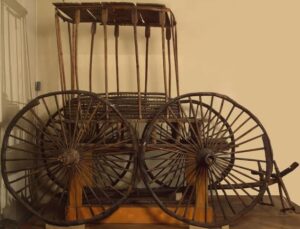Introduction to the Pazyryk Culture and the Discovery of the Ancient Chariot
In recent decades, archaeologists have conducted numerous excavations in the Pazyryk Valley, Gorny Altai, Russia, uncovering kurgans (burial mounds) containing remarkable relics from the Pazyryk culture of the Scythians, which existed during the 5th–4th centuries BCE. One of the most notable discoveries is a 2,300-year-old chariot from Kurgan No. 5, a well-preserved artifact thanks to the permafrost in Siberia. This chariot holds tremendous archaeological significance, offering a new perspective on the engineering and ceremonial practices of the Scythians during the Iron Age.

Unique Structure and Design of the Chariot
1. Materials and Craftsmanship
The Pazyryk chariot is crafted from birch wood, a type of wood common in the Altai Mountains and known for its resistance to decay when preserved in cold environments. The chariot’s structure consists of three interconnected wooden frames, held together by vertical posts, creating a sturdy platform. Leather straps were skillfully woven and attached to the posts, forming a base where a canopy resembling a gazebo was erected. The intricate details in the leatherwork reveal the high skill of Pazyryk artisans and the sophistication in the design.
2. Large Wheels with 34 Spokes Reinforced by Birch Bark
Each wheel of the chariot is made with 34 spokes, a complex design that provides durability and high load-bearing capacity. Notably, the spokes were reinforced with treated birch bark layers glued together. This technique enhanced the wheels’ strength and flexibility, making them suitable for the rugged terrain the Pazyryk people traversed. This design demonstrates advanced mechanical techniques and reflects the Scythians’ efficient use of natural resources.
3. Collapsible Design – Superior Convenience for Harsh Terrain
Another remarkable feature is the chariot’s collapsible structure, allowing the Pazyryk people to carry it over challenging terrain, such as high mountains and valleys, instead of pulling it with animals at all times. This adaptability was especially useful when crossing difficult paths, highlighting the Scythians’ practical ingenuity and their deep understanding of their environment.

Ceremonial Significance of the Chariot
The chariot served not only as a means of transportation but also played a significant role in the Pazyryk people’s rituals and beliefs. The gazebo-like canopy likely symbolized religious or social status and may have been used in burial rituals or special ceremonies.
In Pazyryk kurgans, artifacts like this chariot are closely associated with honoring the deceased, representing the power and social rank of the individuals interred within. The chariot’s intricate design and craftsmanship further emphasize its importance in Pazyryk society.
Importance of the Discovery in Archaeological Research
The discovery of this 2,300-year-old chariot provides invaluable insights into the Pazyryk people’s engineering, knowledge, and practical applications in constructing transportation. The elements of materials, spoke reinforcement, and collapsible design reveal both creativity and adaptability to the harsh geographical conditions.
This discovery not only highlights technical achievements but also contributes to research on ancient social structures and ritual practices. Preserved in the ice, the chariot and other Pazyryk artifacts have survived through millennia to tell the story of a lost civilization, deepening our understanding of the lives and culture of our ancestors.

Conclusion
The Pazyryk chariot stands as a testament to the advanced craftsmanship of the Scythian culture in creating transportation and ceremonial objects. With its unique structure and intelligent design, the chariot reflects both technical skill and the way the Pazyryk people survived and honored tradition. This discovery not only broadens our knowledge of the past but also inspires us in the study and preservation of humanity’s cultural heritage.
